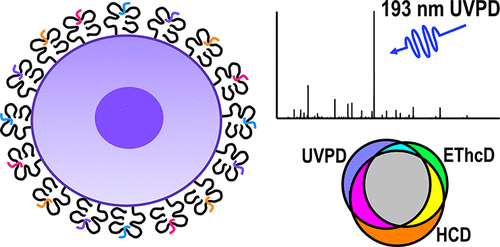当前位置:
X-MOL 学术
›
Anal. Chem.
›
论文详情
Our official English website, www.x-mol.net, welcomes your
feedback! (Note: you will need to create a separate account there.)
Characterization of HLA-A*02:01 MHC Immunopeptide Antigens Enhanced by Ultraviolet Photodissociation Mass Spectrometry
Analytical Chemistry ( IF 6.7 ) Pub Date : 2021-09-23 , DOI: 10.1021/acs.analchem.1c01002 Eleanor Watts 1 , Gregory K Potts 2 , Damien B Ready 2 , Alayna M George Thompson 2 , Janice Lee 2 , Edwin E Escobar 1 , Melanie J Patterson 2 , Jennifer S Brodbelt 1
Analytical Chemistry ( IF 6.7 ) Pub Date : 2021-09-23 , DOI: 10.1021/acs.analchem.1c01002 Eleanor Watts 1 , Gregory K Potts 2 , Damien B Ready 2 , Alayna M George Thompson 2 , Janice Lee 2 , Edwin E Escobar 1 , Melanie J Patterson 2 , Jennifer S Brodbelt 1
Affiliation

|
Identifying major histocompatibility complex (MHC) class I immunopeptide antigens represents a key step in the development of immune-based targeted therapeutics and vaccines. However, the complete characterization of these antigens by tandem mass spectrometry remains challenging due to their short sequence length, high degree of hydrophobicity, and/or lack of sufficiently basic amino acids. This study seeks to address the potential for 193 nm ultraviolet photodissociation (UVPD) to improve the analysis of MHC class I immunopeptides by offering enhanced characterization of these sequences in lower charge states and differentiation of prominent isomeric leucine and isoleucine residues in the HLA-A*02:01 motif. Although electron transfer dissociation-higher energy collisional dissociation (EThcD) offered some success in the differentiation of leucine and isoleucine, 193 nm UVPD was able to confirm the identity of nearly 60% of leucine and isoleucine residues in a synthetic peptide mixture. Furthermore, 193 nm UVPD led to significantly more peptide identifications and higher scoring metrics than EThcD for peptides obtained from immunoprecipitation of MHC class I immunopeptides from in vitro cell culture. Additionally, 193 nm UVPD represents a promising complementary technique to higher-energy collisional dissociation (HCD), in which 424 of the 2593 peptides identified by 193 nm UVPD were not identified by HCD in HLA-A*02:01-specific immunoprecipitation and 804 of the 3300 peptides identified by 193 nm UVPD were not identified by HCD for pan HLA-A, -B, and -C immunoprecipitation. These results highlight that 193 nm UVPD offers an option for the characterization of immunopeptides, including differentiation of leucine and isoleucine residues.
中文翻译:

紫外光解离质谱增强 HLA-A*02:01 MHC 免疫肽抗原的表征
识别主要组织相容性复合物 (MHC) I 类免疫肽抗原是开发基于免疫的靶向治疗药物和疫苗的关键步骤。然而,由于这些抗原的序列长度短、疏水性高和/或缺乏足够的碱性氨基酸,因此通过串联质谱法对这些抗原进行完整表征仍然具有挑战性。本研究旨在解决 193 nm 紫外光解 (UVPD) 的潜力,通过提供这些序列在较低电荷状态下的增强表征和 HLA-A* 中突出的异构亮氨酸和异亮氨酸残基的区分来改进 MHC I 类免疫肽的分析02:01 主题。尽管电子转移解离-高能碰撞解离 (EThcD) 在区分亮氨酸和异亮氨酸方面取得了一些成功,但 193 nm UVPD 能够确认合成肽混合物中近 60% 的亮氨酸和异亮氨酸残基的身份。此外,对于从来自体外细胞培养。此外,193 nm UVPD 代表了一种有前途的高能碰撞解离 (HCD) 技术,其中 193 nm UVPD 鉴定的 2593 种肽中有 424 种在 HLA-A*02:01 特异性免疫沉淀和 804对于泛 HLA-A、-B 和 -C 免疫沉淀,HCD 未鉴定出通过 193 nm UVPD 鉴定的 3300 种肽。这些结果突出表明,193 nm UVPD 为免疫肽的表征提供了一种选择,包括区分亮氨酸和异亮氨酸残基。
更新日期:2021-10-06
中文翻译:

紫外光解离质谱增强 HLA-A*02:01 MHC 免疫肽抗原的表征
识别主要组织相容性复合物 (MHC) I 类免疫肽抗原是开发基于免疫的靶向治疗药物和疫苗的关键步骤。然而,由于这些抗原的序列长度短、疏水性高和/或缺乏足够的碱性氨基酸,因此通过串联质谱法对这些抗原进行完整表征仍然具有挑战性。本研究旨在解决 193 nm 紫外光解 (UVPD) 的潜力,通过提供这些序列在较低电荷状态下的增强表征和 HLA-A* 中突出的异构亮氨酸和异亮氨酸残基的区分来改进 MHC I 类免疫肽的分析02:01 主题。尽管电子转移解离-高能碰撞解离 (EThcD) 在区分亮氨酸和异亮氨酸方面取得了一些成功,但 193 nm UVPD 能够确认合成肽混合物中近 60% 的亮氨酸和异亮氨酸残基的身份。此外,对于从来自体外细胞培养。此外,193 nm UVPD 代表了一种有前途的高能碰撞解离 (HCD) 技术,其中 193 nm UVPD 鉴定的 2593 种肽中有 424 种在 HLA-A*02:01 特异性免疫沉淀和 804对于泛 HLA-A、-B 和 -C 免疫沉淀,HCD 未鉴定出通过 193 nm UVPD 鉴定的 3300 种肽。这些结果突出表明,193 nm UVPD 为免疫肽的表征提供了一种选择,包括区分亮氨酸和异亮氨酸残基。











































 京公网安备 11010802027423号
京公网安备 11010802027423号